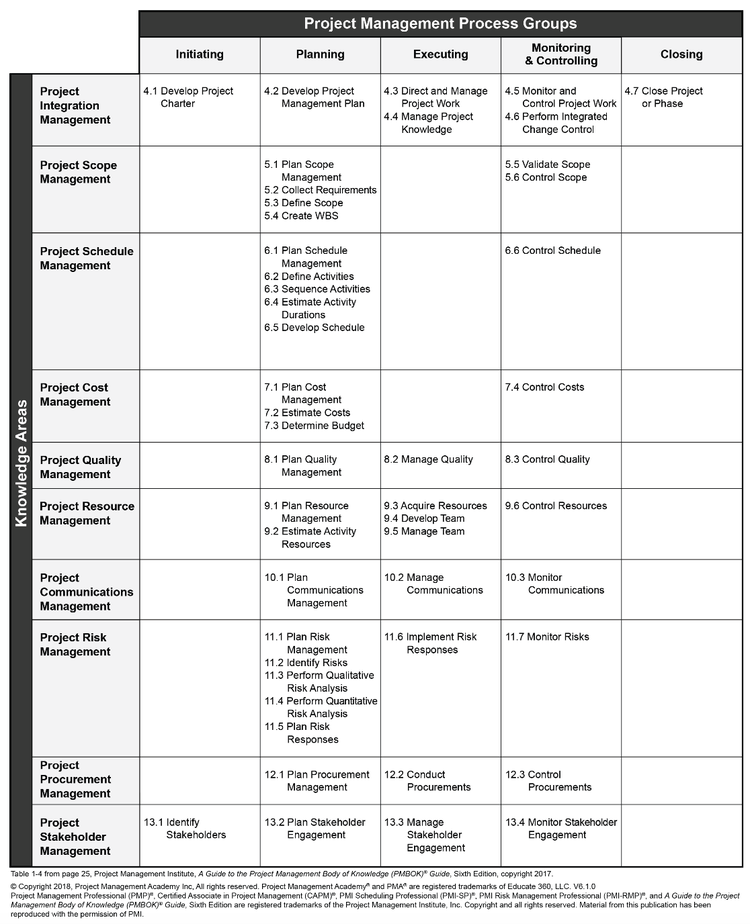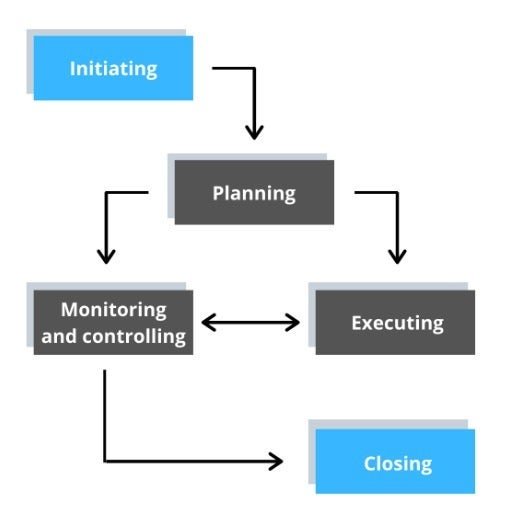

Image source: Getty Images
If you’re looking for the ultimate blueprint (no pun intended) on everything you need to pass your project management certification, you can do no better than the PMBOK (Project Management Body of Knowledge).
Whether you’ve chosen project management as your career path or you’ve stumbled into this responsibility, this guide is the perfect resource for learning everything there is to know about planning, executing, and completing team-based projects.
You’ll learn everything from work breakdown structures to risk management and anything in between from the PMBOK Guide. These skills are extremely useful no matter if you’re working in IT project management or marketing project management.
However, if you don’t have time to go through those detailed guide books, we have plenty of introductory content here at The Ascent that’ll help you get started. So, let’s start with the basics like project management process groups.
Overview: What are project management process groups?
The five process groups in project management according to PMBOK Guide are distinct phases that encompass certain actions and activities necessary for successfully completing a project.
Sort of like the project life cycle. If there is one thing I can say for sure about the project management industry, we love to create lots of different terms to describe very similar processes.
These phases require certain skills that are specific to these process groups, known as knowledge areas. The ten PMBOK knowledge areas are:
- Project integration management
- Project scope management
- Project schedule management
- Project cost management
- Project quality management
- Project resource management
- Project communications management
- Project risk management
- Project procurement management
- Project stakeholder management
In order to better understand these knowledge areas, PMBOK has laid each one of them out along with the individual project manager responsibilities in conjunction with the five process groups. This is known as knowledge area mapping.

This chart maps out each of the knowledge areas a project manager must understand. Image source: Author
As for the system itself, every project incorporates these PMBOK process groups which break down into a chart that’ll guide you from start to finish in your project:

These process groups are very straightforward and simple but are crucial for any project to succeed. Image source: Author
These project management basics give the manager the organizational structure to successfully plan, conduct, and wrap up any project thrown at them.
The 5 project management process groups
Now that you have a fundamental understanding of what the process groups are, let’s go through each process and go through the average expectations for each one.
1. Initiating
It’s time to kick everything off with the initiation phase. Your vision is established at this point while all of the pieces, processes, and beneficiaries are identified in order to ensure the successful delivery of the project.
This process group gives you the opportunity to justify the need for whatever deliverables your team hopes to provide.
Initiating includes:
- Identify the purpose of this project: Determine the need for this project by establishing what it will accomplish.
- Identify the stakeholders: Who is the project meant to benefit and how will the deliverables benefit them.
- Outline the project scope: Collaborate with your project team, stakeholders, and all other involved parties to define the scope of this project.
2. Planning
If you’ve made it this far, you’ve clearly made a sufficient case for this project. That means it’s time to take all that you know and build on it in order to develop your project management plan.
These plans will vary, but your project planning process group will include developing budgets, establishing project timelines, and identifying team roles.
Planning includes:
- Develop a budget: How much do you plan on spending in order to deliver this project according to expectations? Create a budget as a framework for how much you intend to spend during execution and as a means to track actual spending.
- Perform a risk assessment: No project is without risk. That’s why it’s important to perform a risk assessment in order to identify potential issues before they become a reality.
- Create a project schedule and roadmap: Take all that you know from your project scope, risk assessment, and your experience with similar projects in order to put together a schedule and roadmap.
- Assign roles and responsibilities: Find out who will do what, when, and where by assigning all of your project roles and responsibilities to your team members.
3. Executing
Now that everything is ready to go, it’s time to pull the trigger on this project. Executing is the third project management process group and it’s easily the most exciting and engaging aspect of this project life cycle.
Depending on which of the project management methodologies you choose, this will either be an iterative and reciprocal process or a linear process regarding deliverables, stakeholders, and your team.
Executing includes:
- Getting the work done: This is the obvious directive of this process group. Everything you’ve planned is put into action and delivered to the stakeholders.
- Regularly meet with your team: It’s important that you maintain a healthy level of engagement with your team in order to understand the process, make suggestions, and ensure deliverables that meet the expectations of stakeholders.
4. Monitoring and controlling
This project process group works hand-in-hand with the previous group in a reciprocal manner, as shown in the chart above.
As you execute your project plan, it’s important to make sure that you keep an eye on the progress you’re making in order to identify any issues if they arise. This process group is all about quality control and maintaining expectations for the project deliverables.
Monitoring and controlling includes:
- Monitor your project progress: Using your project management software and communication skills, you’ll have to regularly check in on the progress your team is making. Be sure to measure everything from task completion times to your project budget.
- Put together status reports for your stakeholders: This depends on the methodology you’ve chosen, but if you’re operating on an agile framework, you’ll want to check in with your stakeholders, complete with project status reports.
5. Closing
It’s the end of the road for your project, and it’s time to wrap up all of your loose ends. This includes finalizing the delivery of all tasks, archiving project records, meeting with stakeholders, and performing a post-project analysis.
Closing includes:
- Create a final project report: This analysis will detail all of the relevant project metrics your team was tracking during the execution phase, including productivity, return on investment, and schedule variation.
- Hold a final stakeholder meeting: Now that you’ve completed your project be sure to hold at least one final meeting with the project stakeholders in order to ensure their satisfaction with the deliverables.
- Archive all project records: These records will provide a detailed paper trail of the plan, process, and budget of the project. These records are useful in determining the value of similar future projects.
Everything you need to know to get started in project management
Whether you’re learning about project management process groups, the project management steps, or developing a critical path for your team to follow, The Ascent has a lot to offer those new to project management and others looking to brush up on their knowledge.
We have plenty of how-to guides, project management software reviews, software comparisons, and alternatives lists, so be sure to check them out.